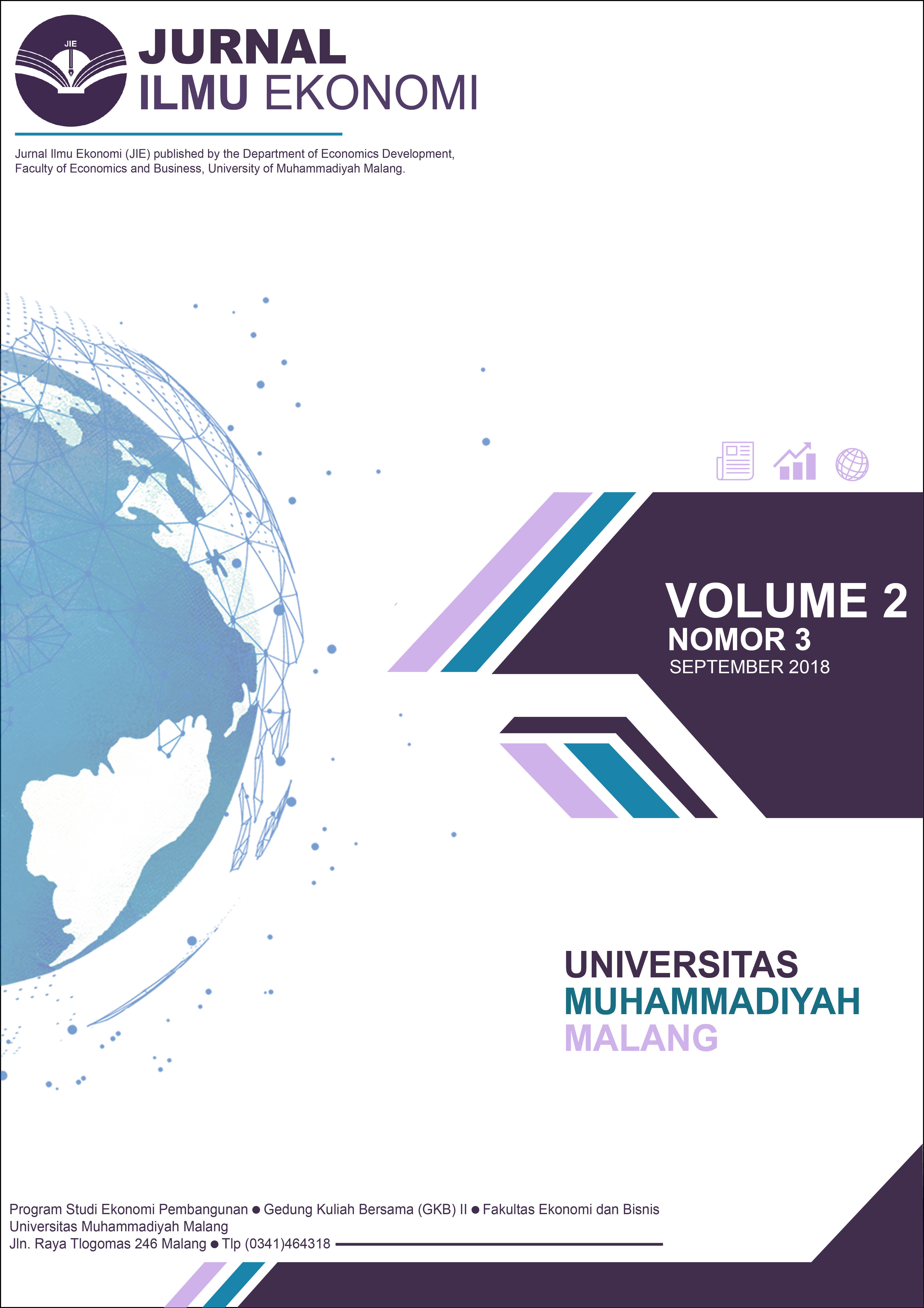ANALISIS PENYALURAN KREDIT MODAL KERJA PADA BANK UMUM DI INDONESIA
DOI:
https://doi.org/10.22219/jie.v2i3.7116Abstract
This study aims to describe the development of Third Party Funds (DPK), Lending Rates (SBK), Non Performing Loan (NPL) and loan portfolio of working capital as well as to analyze the influence of Third Party Funds, Interest Rates, Non Performing Loan to lending working capital commercial banks in Indonesia in 2012-2016. Data analysis technique used is the panel data regression analyzes were then performed hypothesis testing by F test, t test, and the coefficient of determination (R²) at a significance level α = 5%. The results showed that the variables simultaneously DPK, SBK and NPL effect on working capital loans. While partially, DPK variable positive and significant impact, SBK negative and significant effect, and NPL negative and not significant to the working capital loans at commercial banks in Indonesia. The coefficient of determination (R²) is 0.7569 or 75.69%. This indicates that the variable DPK, SBK and NPL able to explain the variable lending working capital amounted to 75.69%.
Keywords : Third Party Funds, Interest Rates, Non-Performing Loans, Working Capital Loans
Downloads
References
DAFTAR PUSTAKA
Abdullah, M. F. (2005). Manajemen Perbankan; Teknik Analisis Kinerja Keuangan Bank. Malang: UMM Press.
Akbar, D. A. (2012). Kausalitas Inflasi , Tingkat Suku Bunga , dan Jumlah Uang Beredar : A Case of Indonesia Economy. Forum Bisnis Dan Kewirausahaan Jurnal Ilmiah STIE MDP, 2(1), 59–68.
Budisantoso, T., & N. (2014). Bank dan Lembaga Keuangan Lain. Jakarta: Salemba Empat.
Fithriyah, Z., & Malik, N. (2010). Pengaruh Kredit Perbankan Terhadap Pertumbuhan Industri Manufaktur dalam Menunjang Pertumbuhan Ekonomi Indonesia. Jurnal Ekonomi Pembangunan, 8(1), 209–214. Retrieved from http://ejournal.umm.ac.id/index.php/jep/article/view/968
Fitri, L. (2017). Pengaruh Suku Bunga Kredit, Dana Pihak Ketiga (DPK), dan Giro Wajib Minimum Terhadap Penyaluran Kredit Pada PT. Bank Central Asia, TBK. di Indonesia Tahun 2001-2015. JOM Fekon, 4(1), 379–392.
Ismail. (2011). Manajemen Perbankan; Dari Teori Menuju Aplikasi. Jakarta: Kencana.
Kasmir. (2008). Bank dan Lembaga Keuangan Lainnya. Jakarta: PT. RajaGrafindo Persada.
Ningsih, D., & Zuhroh, I. (2010). Analisis Permintaan Kredit Investasi pada Bank Swasta Nasional di Jawa Timur. Jurnal Ekonomi Pembangunan, 8(2), 345–355.
Oktaviani, & Pangestuti, I. R. D. (2012). Pengaruh DPK, ROA, CAR, NPL dan Jumlah SBI Terhadap Penyaluran Kredit Perbankan (Studi pada Bank Umum Go Public di Indonesia Periode 2008-2011). Diponegoro Journal of Management, 1(2), 430–438.
Subuh, L., Zuhroh, I., & Abdullah, M. F. (2014). Komparasi Kinerja Keuangan Bank Nasional dan Bank Asing Tahun 2010-2014. Jurnal Ekonomi Pembangunan, 204–217.
Susilo, Y. S., Triandaru, S., & Santoso, A. . (2000). Bank & Lembaga Keuangan Lain. Jakarta: Salemba Empat.
Downloads
How to Cite
Issue
Section
License
Authors who publish with this journal agree to the following terms:
- For all articles published in the JIE (Jurnal Ilmu Ekonomi), copyright is retained by the authors. Authors give permission to the publisher to announce the work with conditions. When the manuscript is accepted for publication, the authors agree to the automatic transfer of non-exclusive publishing rights to the publisher.
- Authors retain copyright and grant the journal right of first publication with the work simultaneously licensed under a Creative Commons Attribution-NonCommercial-ShareAlike 4.0 International License that allows others to share the work with an acknowledgement of the work's authorship and initial publication in this journal.
- Authors are able to enter into separate, additional contractual arrangements for the non-exclusive distribution of the journal's published version of the work (e.g., post it to an institutional repository or publish it in a book), with an acknowledgement of its initial publication in this journal.
- Authors are permitted and encouraged to post their work online (e.g., in institutional repositories or on their website) prior to and during the submission process, as it can lead to productive exchanges, as well as earlier and greater citation of published work (See The Effect of Open Access).
This is an open access article and licensed under a Creative Commons Attribution-NonCommercial-ShareAlike 4.0 International License








